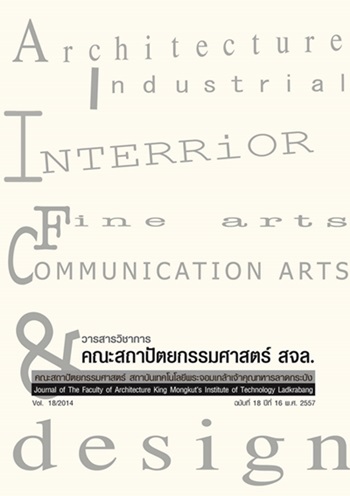การออกแบบสถาปัตยกรรมภายในห้องเรียนเด็กปฐมวัยโดยใช้การเรียนรู้ แบบใช้สมองเป็นพื้นฐาน : Interior Architecture Within the Early Childhood Classroom Focusing on Brain Based Learning
Main Article Content
Abstract
บทคัดย่อ
การศึกษาการออกแบบสถาปัตยกรรมภายในห้องเรียนเด็กปฐมวัยโดยใช้การเรียนรู้แบบใช้สมองเป็นพื้นฐาน (BrainBased Learning) วัตถุประสงค์เพื่อ 1) ศึกษาปัจจัยที่มีผลต่อการออกแบบสถาปัตยกรรมภายในห้องเรียนเด็กปฐมวัยโดยใช้การเรียนรู้แบบใช้สมองเป็นพื้นฐาน 2) ออกแบบสถาปัตยกรรมภายในห้องเรียนเด็กปฐมวัยโดยใช้การเรียนรู้แบบใช้สมองเป็นพื้นฐาน วิธีการดำเนินการวิจัย ศึกษาทฤษฎีและงานวิจัยที่เกี่ยวข้องการสร้างเครื่องมือวิจัยได้แก่ แบบสอบถาม แบบสังเกตแบบสัมภาษณส์ งั เกตพฤตกิ รรมการเรียนการสอนโรงเรยี นสังกัดสำนักงานคณะกรรมการการศึกษาขั้นพืน้ ฐาน ทีจั่ดการเรยี นการสอนระดับปฐมวัย สุ่มตัวอย่างแบบง่าย (Sample Random Sampling) จำนวน 20 แห่ง ผลการวิจัยพบว่าปัจจัยที่มีผลต่อการออกแบบสถาปัตยกรรมภายในห้องเรียนของเด็กปฐมวัยโดยใช้การเรียนรู้แบบใช้สมองเป็นพื้นฐานคือ 1) ความสัมพันธ์ของการใช้พื้นที่ว่างภายในห้องรองรับกิจกรรมที่ใช้ร่วมและกิจกรรมมุมประสบการณ์ 2) รูปแบบเครื่องเรือนสามารถเคลื่อนย้ายได้สะดวกมีขนาดเหมาะสม น้ำหนักเบา และปลอดภัย เช่น ชั้นวาง โต๊ะเรียน กระดาน 3) สี ใช้โทนสีอ่อน(พาสเทล) และสีธรรมชาติ เน้น สีเขียว สีเหลือง 4) ใช้วัสดุธรรมชาติ ปลอดภัยต่อเด็กและมีในท้องถิ่นเช่นไม้ไผ่ ผ้าไหม กะติ๊บข้าว เป็นต้น5) มุมกิจกรรมที่ส่งผลต่อการเรียนรู้ ได้แก่ มุมบล็อก มุมบ้านสมมติ มุมหนังสือ มุมดนตรี เป็นต้น สรุปแนวทางการออกแบบห้องเรียนเด็กปฐมวัยที่มีความเหมาะสมมี 2 ขนาดห้อง ได้แก่ ห้องเรียน ขนาด กว้าง 6.00 เมตร ยาว 9.00 เมตร และห้องเรียนขนาด กว้าง 10.50 เมตร ยาว 12.00 เมตร ห้องสูง 3.00 เมตร ส่วนประกอบของห้องตามที่เสนอการออกแบบภายในเน้นให้สภาพแวดล้อมของห้องเรียนคือ ผนัง พื้น เครื่องเรือนเป็นส่วนหนึ่งในการเรียนรู้โดยครูและเด็กมีปฏิสัมพันธ์ส่วนร่วมในการปรับและสร้างสภาพแวดล้อม สีสันใช้โทนสีธรรมชาติ เขียว เหลือง ในโทนอุ่นและสีสันของพาสเทล บวกกับความสดใสของสีสันชั้นเก็บสื่ออุปกรณ์ และเน้นพื้นที่ว่างเพื่อรองรับกับกิจกรรมที่ใช้ร่วม และกิจกรรมส่วนตัวของมุมประสบการณ์ต่างๆ โดยออกแบบให้ชั้นวางสื่อ อุปกรณ์ โต๊ะเรียนและผนังสามารถที่จะเลื่อนปรับเปลี่ยนตำแหน่งได้สะดวกเพื่อเพิ่มบรรยากาศที่หลากหลายสอดคล้องกิจกรรมการเรียนรู้
คำสำคัญ: สถาปัตยกรรมภายใน การเรียนรู้แบบใช้สมองเป็นพื้นฐาน
Abstract
The objective of this research is to study the design of early childhood classroom focusing on brainbased learning. The research is dividing into two areas of study 1) The factors which affect the design ofearly childhood classroom focusing on brain based learning. 2) The designing of early childhood classroomfocusing on brain based learning, research method, study of theories and related research. Research toolsinclude questionnaires, observations, interviews observing teaching behavior of 20 schools under Office of theBasic Education Commission which provide early childhood education by using simple random sampling. Theresearch found that factors which affect the design of early childhood classroom focusing on brain based learning are 1) Relation of the use of empty space within the room supporting sharing activities and experiencecorner. 2) Furniture can be easily moved with suitable size, lightweight and safe such as shelf, desk andboard. 3) Using light color (pastel) and natural color emphasizing on green and yellow. 4) Using natural materials,safe for children and locally available such as bamboo, silk and sticky rice box. 5) Activity corners whichaffect learning are block corner, home corner, book corner and music corner. The appropriate design of earlychildhood classroom have two sizes ; 6.00 meters wide and 9.00 meters long classroom and 10.50 meterswide and 12.00 meters long classroom. The height is 3.00 meters and components in the room as proposed.The interior design focuses that wall, floor, furniture is part of learning. Teachers and children have interactionand participate in adjusting and building environment. Natural colors, yellow, green in warm tone, pastel colorsand bright colors of media storage shelf are used. The focus is on empty space to support sharing activitiesand personal activities in each corner by designing media shelf, equipment, desk and wall to be easilyadjusted in order to create various environments in learning activities.
Keywords: Interior Architecture Brain Based Learning
Article Details
This work is licensed under a Creative Commons Attribution-NonCommercial-ShareAlike 4.0 International License.
Copyright Transfer Statement
The copyright of this article is transferred to Journal of The Faculty of Architecture King Mongkut's Institute of Technology Ladkrabang with effect if and when the article is accepted for publication. The copyright transfer covers the exclusive right to reproduce and distribute the article, including reprints, translations, photographic reproductions, electronic form (offline, online) or any other reproductions of similar nature.
The author warrants that this contribution is original and that he/she has full power to make this grant. The author signs for and accepts responsibility for releasing this material on behalf of any and all co-authors.


